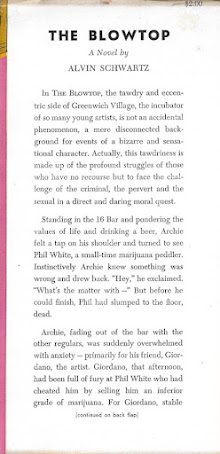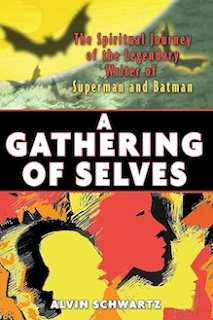Hot Star
Robert W. Tracy [Alvin Schwartz]
New York: Arco, 1952
179 pages
Betty and Bob's honeymoon was a disaster, but don't blame the bride. Bob had been burned – their nuptial room didn't even feature a bath – yet he couldn't bring himself to complain to the front desk. The clerk had spotted him as a virgin, and Bob wasn't about to subject himself to further humiliation. Betty too had been a virgin. She'd imagined their wedding night as one of romance, sensuality, and tender passion, only to have her groom become a pouty, demanding man-child:
"I thought when we talked it over you understood – that a man's got to... Oh why can't you be sensible about it, Betty? You – you act as though I'm not your husband. Haven't I got a right after all this waiting? What are you trying to do – torture me more?
There would be no dinner, no dancing, and no time to change into something more comfortable.
Flash forward two weeks. The couple are still married, if not entirely happily. Bob works the assembly line at the Ross Machinery Company, while Betty spends her days keeping their tiny rented home. Her nights are spent warding off Bob's advances – often unsuccessfully – "wondering if that was all sex was; something for a
man to enjoy."
Betty's dreams of becoming a professional actress make life somewhat bearable – what's more, it gets her out of the house. Cast as the lead in a community theatre production of
Anna, a drama about a boozy floozy, she researches the role by pulling up a stool at a local bar. Lest anything go wrong, Bob sits in the adjoining dining room.
A handsome man in brown gaberdine topcoat buys Betty a highball. Betty is certain he's trying to pick her up, until he introduces himself as Carl Perepoint, a director at Experimental Motion Picture Studios: "You don't mean you are interested in me as-as – Oh, no! I can't believe it."
In fact, Perepoint was trying to pick her up, but Betty's mention of nearby Bob put an end to that.
And what of Bob? What is his dream? Well, he hopes to one day leave the assembly line for a career as a comic strip artist. If anything, this is an even more uncommon occupation than professional actress, but it would've been familiar to Alvin Schwartz, who between 1942 and 1959 wrote for DC Comics. Bizarro Superman was one of his creations.
I make a point in mentioning this because the introduction of Perepoint propels Hot Star along a path in which we find tropes belonging to comics' Golden Age. Consider Experimental Motion Picture Studios, which is located in a failed amusement park and is owned by a mysterious crime syndicate.
Perepoint would have Betty believe that Experimental is just that – experimental – and is the latest venture of an unnamed Hollywood studio. He takes advantage of the newlywed's naïveté to score footage of her in the flesh, assuring the actress that that this "professional screen test" is an industry standard: "It's very simple Betty... Before we invest money in a girl, we must know her figure as an artist would know it."
Hot Star isn't exactly hot stuff, but then no Arco Sophisticate is. Ellipses serve to suggest.
Perepoint provides Betty with coffee and cigarettes spiked with a drug that promotes sexual arousal. As the it takes effect, he puts on a record, Festival of Aphrodite, and Betty strips.
The girl can't help it.
From this point on, Betty acts as a Pavlovian bitch, becoming aroused whenever the music plays.
Remove the sex and drugs from these dance scenes and you have an ideal tale for Superman's Girl Friend, Lois Lane. A better story, buried within the early chapters, involves Frank Legault, who works the assembly line beside Bob: "He was a powerfully built, blond young man of thirty-one and, despite he handicap of his artificial legs, could stand up at a bench or drilling press for hours."
Frank lost his lower limbs in the war. He peddles pornographic photos on the side and has started screening spicy films at the local union hall with the goal of earning enough money to open a small novelty store. His wife wants to help, but her vision is failing. She's learning Braille.
Frank's is not as sophisticated a story as Betty and Bob's, but isn't it the one you'd rather read? Is it not more real?
I've always preferred Earth-One to Bizarro World.
Favourite passage: Questions regarding punctuation, capitalization, and more are best left addressed to the Arco editor.
He told her that he was going to star her in an adaptation of the Madame Bovary classic, with emphasis on nude love scenes. "especially that scene in the garden where Madame Bovary keeps a tryst with her new lover, while her husband is asleep inside. How does that appeal to you Betty?"
"I've always wanted to play Madame Bovary," she said.
Trivia: Though Hot Star was published sixteen years before Alvin Schwartz left the United States for Canada, there is Canadian content. The second night of Betty and Bob's honeymoon takes place in Montreal:
Their so awfully disappointing second night, when they drank wine, and Bob, instead of becoming an exciting lover under its influence, only became silly and had burst out laughing even while he... until what might have been glorious fulfillment to their romance had become a joke... on her. This stranger, or that Frenchman, she felt sure, would have made her feel... feel....
Object: Cheap paper bound in sturdy yellow boards. The novel proper is followed by nine pages of adverts for other Arco titles, beginning with Touchable (1951), co-written by Schwartz and
Access: One copy is listed for sale online; at US$15.00, it's a steal. Evidence suggests that not even Library and Archives Canada has a copy.
Go get it!
Related post:





































